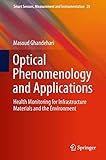Optical Phenomenology and Applications [electronic resource] : Health Monitoring for Infrastructure Materials and the Environment / by Masoud Ghandehari.
By: Ghandehari, Masoud [author.] .
.
Contributor(s): SpringerLink (Online service) .
.
Material type:  BookSeries: Smart Sensors, Measurement and Instrumentation: 28Publisher: Cham : Springer International Publishing : Imprint: Springer, 2018Edition: 1st ed. 2018.Description: XV, 259 p. 161 illus., 95 illus. in color. online resource.Content type: text Media type: computer Carrier type: online resourceISBN: 9783319707150.Subject(s): Telecommunication
BookSeries: Smart Sensors, Measurement and Instrumentation: 28Publisher: Cham : Springer International Publishing : Imprint: Springer, 2018Edition: 1st ed. 2018.Description: XV, 259 p. 161 illus., 95 illus. in color. online resource.Content type: text Media type: computer Carrier type: online resourceISBN: 9783319707150.Subject(s): TelecommunicationThis book is an introduction to techniques and applications of optical methods for materials Characterization in civil and environmental engineering. Emphasizing chemical sensing and diagnostics, it is written for students and researchers studying the physical and chemical processes in manmade or natural materials. Optical Phenomenology and Applications - Health Monitoring for Infrastructure Materials and the Environment, describes the utility of optical-sensing technologies in applications that include monitoring of transport processes and reaction chemistries in materials of the infrastructure and the subsurface environment. Many of the applications reviewed will address long standing issues in infrastructure health monitoring such as the alkali silica reaction, the role of pH in materials degradation, and the remote and inset characterization of the subsurface environment. The remarkable growth in photonics has contributed immensely to transforming bench-top optical instruments to compact field deployable systems. This has also contributed to optical sensors for environmental sensing and infrastructure health monitoring. Application of optical waveguides and full field imaging for civil and environmental engineering application is introduced and chemical and physical recognition strategies are presented; this is followed by range of filed deployable applications. Emphasizing system robustness, and long-term durability, examples covered include in-situ monitoring of transport phenomena, imaging degradation chemistries, and remote sensing of the subsurface ground water.


There are no comments for this item.